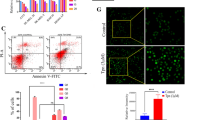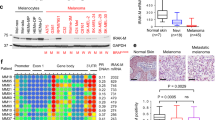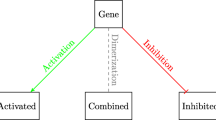Abstract
Purpose
Although treatment of melanoma with BRAF inhibitors and immune checkpoint inhibitors achieves a high response rate, a subset of melanoma patients with intrinsic and acquired resistance are insensitive to these therapeutics, so to improve melanoma therapy other target molecules need to be found. Here, we screened our chemical library to identify an anti-melanoma agent and examined its action mechanisms to show cell growth inhibition activity.
Methods
We screened a chemical library against multiple skin cancer cell lines and conducted ingenuity pathway analysis (IPA) to investigate the mechanisms of CH5552074 activity. Suppression of microphthalmia-associated transcription factor (MITF) expression levels was determined in melanoma cells treated with CH5552074. Cell growth inhibition activity of CH5552074 was evaluated in MITF-dependent melanoma cell lines.
Results
We identified an anti-melanoma compound, CH5552074, which showed remarkable cell growth inhibition activity in melanoma cell lines. The IPA results suggested that CH5552074-sensitive cell lines had activated MITF. In further in vitro studies in the melanoma cell lines, a knockdown of MITF with siRNA resulted in cell growth inhibition, which showed that CH5552074 inhibited cell growth by reducing the expression level of MITF protein.
Conclusions
These results suggest that CH5552074 can inhibit cell growth in melanoma cells by reducing the protein level of MITF. MITF inhibition by CH5552074 would be an attractive option for melanoma treatment.




Similar content being viewed by others
References
Chapman PB, Hauschild A, Robert C et al (2011) Improved survival with vemurafenib in melanoma with BRAF V600E mutation. N Engl J Med 364(26):2507–2516
Flaherty KT, Infante JR, Daud A et al (2012) Combined BRAF and MEK inhibition in melanoma with BRAF V600 mutations. N Engl J Med 367(18):1694–1703
Larkin J, Ascierto PA, Dréno B et al (2014) Combined vemurafenib and cobimetinib in BRAF-mutated melanoma. N Engl J Med 371(20):1867–1876
Johannessen CM, Johnson LA, Piccioni F et al (2013) A melanocyte lineage program confers resistance to MAP kinase pathway inhibition. Nature 504(7478):138–142
Van Allen EM, Wagle N, Sucker A et al (2014) The genetic landscape of clinical resistance to RAF inhibition in metastatic melanoma. Cancer Discov 4(1):94–109
Hodi FS, O’Day SJ, McDermott DF et al (2010) Improved survival with ipilimumab in patients with metastatic melanoma. N Engl J Med 363(8):711–723
Hamid O, Robert C, Daud A et al (2013) Safety and tumor responses with lambrolizumab (Anti–PD-1) in melanoma. N Engl J Med 369(2):134–144
Robert C, Ribas A, Wolchok JD et al (2014) Anti-programmed-death-receptor-1 treatment with pembrolizumab in ipilimumab-refractory advanced melanoma: a randomised dose-comparison cohort of a phase 1 trial. Lancet 384(9948):1109–1117
Postow MA, Chesney J, Pavlick AC et al (2015) Nivolumab and ipilimumab versus ipilimumab in untreated melanoma. N Engl J Med 372(21):2006–2017
King R, Googe PB, Weilbaecher KN et al (2001) Microphthalmia transcription factor expression in cutaneous benign, malignant melanocytic, and nonmelanocytic tumors. The American journal of surgical pathology 25(1):51–57
Levy C, Khaled M, Fisher DE (2006) MITF: master regulator of melanocyte development and melanoma oncogene. Trends Mol Med 12(9):406–414
Wellbrock C, Rana S, Paterson H et al (2008) Oncogenic BRAF regulates melanoma proliferation through the lineage specific factor MITF. PLoS One 3(7):e2734
Garraway LA, Widlund HR, Rubin MA et al (2005) Integrative genomic analyses identify MITF as a lineage survival oncogene amplified in malignant melanoma. Nature 436(7047):117–122
Mizuno H, Nakanishi Y, Ishii N et al (2009) A signature-based method for indexing cell cycle phase distribution from microarray profiles. BMC Genom 10(1):1–10
Krämer A, Green J, Pollard J et al (2014) Causal analysis approaches in ingenuity pathway analysis. Bioinformatics 30(4):523–530
Nakanishi Y, Mizuno H, Sase H et al (2015) ERK signal suppression and sensitivity to CH5183284/Debio 1347, a selective FGFR inhibitor. Mol Cancer Ther 14(12):2831–2839
Miller AJ, Du J, Rowan S et al (2004) Transcriptional regulation of the melanoma prognostic marker melastatin (TRPM1) by MITF in melanocytes and melanoma. Cancer Res 64(2):509–516
Du J, Fisher DE (2002) Identification of Aim-1 as the underwhite mouse mutant and its transcriptional regulation by MITF. J Biol Chem 277(1):402–406
Moffat JG, Rudolph J, Bailey D (2014) Phenotypic screening in cancer drug discovery—past, present and future. Nat Rev Drug Discov 13(8):588–602
Yamaguchi T, Yoshida T, Kurachi R et al (2007) Identification of JTP-70902, a p15(INK4b)-inductive compound, as a novel MEK1/2 inhibitor. Cancer Sci 98(11):1809–1816
Smith MP, Ferguson J, Arozarena I et al (2013) Effect of SMURF2 targeting on susceptibility to MEK inhibitors in melanoma. J Natl Cancer Inst 105(1):33–46
Borgdorff V, Rix U, Winter GE et al (2014) A chemical biology approach identifies AMPK as a modulator of melanoma oncogene MITF. Oncogene 33(19):2531–2539
Yokoyama S, Feige E, Poling LL et al (2008) Pharmacologic suppression of MITF expression via HDAC inhibitors in the melanocyte lineage. Pigment Cell Melanoma Res 21(4):457–463
Smith Michael P, Brunton H, Rowling Emily J et al (2016) Inhibiting drivers of non-mutational drug tolerance is a salvage strategy for targeted melanoma therapy. Cancer Cell 29(3):270–284
Kubic JD, Young KP, Plummer RS et al (2008) Pigmentation PAX-ways: the role of Pax3 in melanogenesis, melanocyte stem cell maintenance, and disease. Pigment Cell Melanoma Res 21(6):627–645
Haq R, Shoag J, Andreu-Perez P et al (2013) Oncogenic BRAF regulates oxidative metabolism via PGC1alpha and MITF. Cancer Cell 23(3):302–315
Gopal YNV, Rizos H, Chen G et al (2014) Inhibition of mTORC1/2 overcomes resistance to MAPK pathway inhibitors mediated by PGC1α and oxidative phosphorylation in melanoma. Cancer Res 74(23):7037–7047
Acknowledgements
The authors thank Eigo Suyama, Nobuya Ishii, Yuko Aoki, Masahiro Aoki, and Osamu Kondoh for helpful discussions and Nobuhiro Oikawa for compound synthesis.
Author information
Authors and Affiliations
Corresponding author
Ethics declarations
Conflict of interest
All of the authors are employees of Chugai Pharmaceutical Co., Ltd.
Ethical approval
This article does not contain any studies with human participants or animals performed by any of the authors.
Electronic supplementary material
Below is the link to the electronic supplementary material.
Rights and permissions
About this article
Cite this article
Aida, S., Sonobe, Y., Yuhki, M. et al. MITF suppression by CH5552074 inhibits cell growth in melanoma cells. Cancer Chemother Pharmacol 79, 1187–1193 (2017). https://doi.org/10.1007/s00280-017-3317-6
Received:
Accepted:
Published:
Issue Date:
DOI: https://doi.org/10.1007/s00280-017-3317-6




